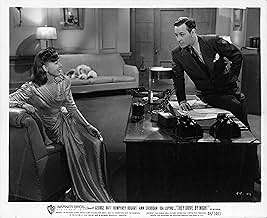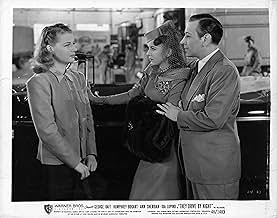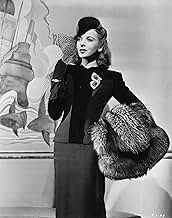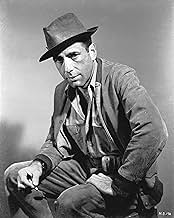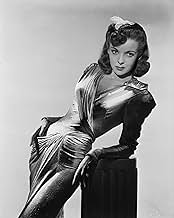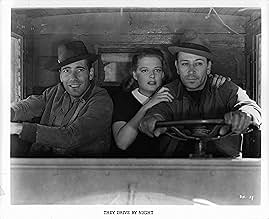Ajouter une intrigue dans votre langueWhen one of two truck-driving brothers loses an arm, they both join a transport company where the other is falsely charged as an accessory in the murder of the owner.When one of two truck-driving brothers loses an arm, they both join a transport company where the other is falsely charged as an accessory in the murder of the owner.When one of two truck-driving brothers loses an arm, they both join a transport company where the other is falsely charged as an accessory in the murder of the owner.
- Réalisation
- Scénario
- Casting principal
- Récompenses
- 2 victoires au total
Eddie Acuff
- Driver in Café
- (non crédité)
William Bendix
- Truck Driver Watching Pinball Game
- (non crédité)
Marie Blake
- Waitress
- (non crédité)
Chet Brandenburg
- Man Griping at Farnsworth
- (non crédité)
Eddy Chandler
- Driver
- (non crédité)
Richard Clayton
- Young Man
- (non crédité)
Joyce Compton
- Sue Carter
- (non crédité)
Alan Davis
- Driver
- (non crédité)
Joe Devlin
- Fatso
- (non crédité)
Avis à la une
Not much action here for a "film noir" and really more of a melodrama than a crime story, but I still like this because the story's decent and it features a top-flight cast of actors who are usually fun to watch.
That cast includes George Raft, Ann Sheridan, Ida Lupino, Humphrey Bogart and Gale Page. My favorite of the group - in this film, at least - is Sheridan, a wise-cracking waitress. Raft and Bogart are truck drivers and Lupino plays the boss' wife. In here, the two women are more interesting than the men, which says a lot considering its Raft and Bogart.
Sheridan not only is easy on the eyes but delivers some great film-noir-type lines. Unfortunately, the edge is taken off her once she leave the diner and hitches a ride with Raft to Los Angeles.
Bogart plays more of a low-key family man whose wife (Page) is the nice- looking, wholesome type. This is one of the last movies Bogart made before he became a star. Hence, he gets fourth billing in here.
Lupino is very good as the vicious scorned woman, a role she found herself playing in a number of films.
As mentioned above, I'm not really sure how one would classify this film since there is humor, film noir, soap opera, straight drama and romance all in it. The combination makes the film interesting and recommended.
That cast includes George Raft, Ann Sheridan, Ida Lupino, Humphrey Bogart and Gale Page. My favorite of the group - in this film, at least - is Sheridan, a wise-cracking waitress. Raft and Bogart are truck drivers and Lupino plays the boss' wife. In here, the two women are more interesting than the men, which says a lot considering its Raft and Bogart.
Sheridan not only is easy on the eyes but delivers some great film-noir-type lines. Unfortunately, the edge is taken off her once she leave the diner and hitches a ride with Raft to Los Angeles.
Bogart plays more of a low-key family man whose wife (Page) is the nice- looking, wholesome type. This is one of the last movies Bogart made before he became a star. Hence, he gets fourth billing in here.
Lupino is very good as the vicious scorned woman, a role she found herself playing in a number of films.
As mentioned above, I'm not really sure how one would classify this film since there is humor, film noir, soap opera, straight drama and romance all in it. The combination makes the film interesting and recommended.
If you could distil the essence of the actors in this quite ordinary film and add to it the forfeit George Raft paid for his poor future choices, the oyster and the world would be yours.
Let's get this out of the way first: Humphrey Bogart's legions of fans seem impelled to insult George Raft as often as possible, no matter how inappropriate or clearly wrong. Those not so blinded will thoroughly enjoy this odd, mixed bag of a picture. Raft and Bogey play brothers - very believably so - who are wildcat truck drivers trying to get ahead in a tough business during the Depression. The film is odd because it seems like two separate movies. It starts out as a seeming social commentary on the hard life of truckers with fine characterizations. But as soon as Ida Lupino appears it veers straight into film noir. I, personally, would have preferred a continuation of the tone of the first part of the film rather than be subjected to the "crazy b----" act that so many call "classic" and "stealing the picture." There either should have been more foreshadowing of this switch early in the film, or the screenwriters should have found something more consistent. At any rate, Raft and Bogart get to step away from gangster roles for a breather. They're still tough guys, but they're vulnerable to the whims of fate. Raft, in fact, is adorable here, uncharacteristically blue-collar and common, desperate to be in charge of his own life. He has instant chemistry with no-nonsense Ann Sheridan. Raft works so comfortably under Walsh's direction, it's rather refreshing. If rumors are true and Bogart and Raft were not getting along at this point, they were both professionals and hid it very well. Blame Lupino, but by the second half of the film, Bogart practically disappears just when we'd like to see more development of his very sympathetic character. For Bogart fans, this is not a "Bogey" film. He's simply prepping for legend-status just around the corner. It would have been nice to see more of Sheridan, as well. I don't recall Alan Hale ever being better than he is here - watch the small things he does with such a loud character. Lupino is definitely unforgettable, and her cult following will love this. Roscoe Karns is again a fun comic foil. The editing of the picture is sometimes a bit rough, and there is a telephone sequence that does not visually work. Arthur Edeson was a frustratingly inconsistent cinematographer, ranging from brilliant work like "Casa Blanca" to B level work. This is somewhere in the middle, but the road sequences are great.
Truck-driving brothers GEORGE RAFT and HUMPHREY BOGART not only have to put up with the hazards of wildcat driving but the manipulations of the scheming wife of boss ALAN HALE, played with intense conviction by IDA LUPINO.
But it's a plodding tale that takes awhile to work up any steam while director Raoul Walsh concentrates on the rough-housing camaraderie of the blue collar set before getting to the heart of the story involving two very different women--the good one, ANN SHERIDAN, and the femme fatale played with relish by IDA LUPINO. It is the romantic trio that ends in tragedy that gives the film its potent interest.
Lupino's mad scene on the stand is worth waiting for--although not entirely convincing. Nevertheless, she creates a vixen you won't soon forget.
George Raft ambles pleasantly through a rather dull role while Humphrey Bogart, as his brother, attracts more attention in a sideline role. Ann Sheridan is a sheer delight, adding her usual warmth and zest to a typical Sheridan role. The script crackles with tart remarks.
Not exactly great filmmaking--and too long in getting started--but worth the wait for some good performances. Only drawback seemed to be ALAN HALE as an oafish boss who becomes even more obnoxious when he's drunk. Hale overplays the role to such a degree that, in a way, it comes as a relief to see Ida knock him off with those car doors. "The doors made me do it!" is her scream from the witness stand.
Summing up: the kind of melodrama Warner was famous for in the '40s with the right cast doing it justice.
But it's a plodding tale that takes awhile to work up any steam while director Raoul Walsh concentrates on the rough-housing camaraderie of the blue collar set before getting to the heart of the story involving two very different women--the good one, ANN SHERIDAN, and the femme fatale played with relish by IDA LUPINO. It is the romantic trio that ends in tragedy that gives the film its potent interest.
Lupino's mad scene on the stand is worth waiting for--although not entirely convincing. Nevertheless, she creates a vixen you won't soon forget.
George Raft ambles pleasantly through a rather dull role while Humphrey Bogart, as his brother, attracts more attention in a sideline role. Ann Sheridan is a sheer delight, adding her usual warmth and zest to a typical Sheridan role. The script crackles with tart remarks.
Not exactly great filmmaking--and too long in getting started--but worth the wait for some good performances. Only drawback seemed to be ALAN HALE as an oafish boss who becomes even more obnoxious when he's drunk. Hale overplays the role to such a degree that, in a way, it comes as a relief to see Ida knock him off with those car doors. "The doors made me do it!" is her scream from the witness stand.
Summing up: the kind of melodrama Warner was famous for in the '40s with the right cast doing it justice.
They Drive by Night (AKA: The Road to Frisco) is directed by Raoul Walsh and adapted by Jerry Wald & Richard Macaulay from the novel "The Long Haul" written by A. I. Bezzerides. It stars George Raft, Ann Sheridan, Ida Lupino and Humphrey Bogart. Adolph Deutsch scores the music and Arthur Edeson is the cinematographer. Plot finds Raft & Bogart playing the Fabrini brothers, two guys trying to make a living as truck drivers during the Depression era. Just about keeping afloat in a very competitive market, the boys find that they have to work longer hours to stay ahead in the game. But that brings fatigue and danger, and with the repo men after them they could do with a break; a break that comes by way of work for Ed Carlson (Alan Hale). But the fortune is short lived as trouble awaits, not only on the road, but also in the form of Carlson's wife, Lana (Lupino).
Warner Brothers produce a film of two differing halves that blends social realism with film noir edges. The script is tight as the narrative firstly deals in an adventure with period detail, then shifts to drama as bad luck and a bad woman come into play. There's zippy dialogue to digest, too, while Walsh keeps the pace brisk and provides good attention to detail in relation to the subject of the trucking industry. With Bogart a year away from leading man status (High Sierra/The Maltese Falcon), he was fourth billed for this movie. He gets relegated to the sidelines for the second half of the piece but by then he had made his mark. Sheridan is effective, in what ultimately is a love interest role, while Raft dominates as the centre piece character. But it's Lupino's movie all the way. True enough to say that her pivotal scene has a touch of the over theatrical histrionics about it, but it works in context to how she had formed the character up to then. Playing it man hungry and vixen like; yet with a sternness that oozes business woman sensibilities, her performance earned her a studio contract.
Two movies for the price of one, then, and nary a dull moment in either of them. 7.5/10
Warner Brothers produce a film of two differing halves that blends social realism with film noir edges. The script is tight as the narrative firstly deals in an adventure with period detail, then shifts to drama as bad luck and a bad woman come into play. There's zippy dialogue to digest, too, while Walsh keeps the pace brisk and provides good attention to detail in relation to the subject of the trucking industry. With Bogart a year away from leading man status (High Sierra/The Maltese Falcon), he was fourth billed for this movie. He gets relegated to the sidelines for the second half of the piece but by then he had made his mark. Sheridan is effective, in what ultimately is a love interest role, while Raft dominates as the centre piece character. But it's Lupino's movie all the way. True enough to say that her pivotal scene has a touch of the over theatrical histrionics about it, but it works in context to how she had formed the character up to then. Playing it man hungry and vixen like; yet with a sternness that oozes business woman sensibilities, her performance earned her a studio contract.
Two movies for the price of one, then, and nary a dull moment in either of them. 7.5/10
Le saviez-vous
- AnecdotesThe wife of producer Mark Hellinger, Gladys Glad, a former showgirl for Broadway producer Florenz Ziegfeld Jr., was responsible for getting this film made. Hellinger had brought home a large stack of scripts that he was to read for filming consideration. He had leafed through the script and read the summary, but felt that "nobody would pay money to see a bunch of truck drivers." His wife read this script, liked it, and pressured Hellinger to read it. Reluctantly, he did, the film eventually got made, and it became the sleeper hit of the year for Warners. It was made for an estimated $400,000 and grossed more than $4 million. (Source: Book "The Mark Hellinger Story" by Jim Bishop, New York: Appleton-Century-Crofts, 1952)
- GaffesWhen Joe and Paul's truck crashes, a motorist in a 1933 Cadillac with California license number 2N 214 stops to give assistance. Later, at Ed and Lana Carlson's anniversary party the same car (and same license number) is shown as one of Ed's cars as he demonstrates his garage door opener.
- Citations
Ed Carlsen: Early to rise and early to bed, makes a man healthy, but socially dead!
- ConnexionsFeatured in Hollywood: The Great Stars (1963)
- Bandes originalesWhen the Swallows Come Back to Capistrano
(1940) (uncredited)
Music by Leon René
Played at Mandel's Cafe
Meilleurs choix
Connectez-vous pour évaluer et suivre la liste de favoris afin de recevoir des recommandations personnalisées
- How long is They Drive by Night?Alimenté par Alexa
Détails
Box-office
- Budget
- 400 000 $US (estimé)
- Durée1 heure 35 minutes
- Couleur
- Rapport de forme
- 1.33 : 1
Contribuer à cette page
Suggérer une modification ou ajouter du contenu manquant


